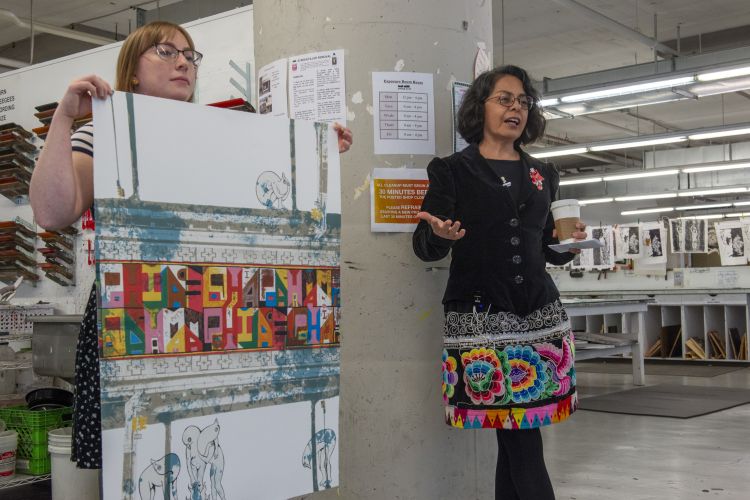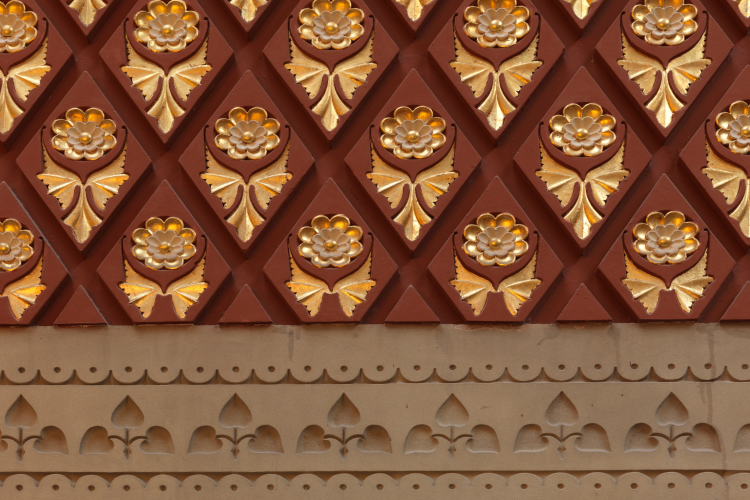STORIES FROM PAFA
When Art Meets the World: In Conversation with Student Dara Haskins

Creating art is a very personal activity, and being an artist often means putting these personal experiences on display for others to see and react to. For student artists, having exhibition opportunities can be a testing-ground for how their work will be received in the wider community. How does an artist handle the multiplicity of interpretations that can sometimes be assigned to their work once it leaves the studio? How can a young artist navigate controversial content? These questions became front and center this fall for Dara Haskins, a third-year BFA student working in painting and sculpture.
Haskins came to PAFA from Baltimore, where she was involved with making murals in the local arts community. It was through a mural project that she met artist Amy Sherald, who among other accomplishments was recently commissioned to paint former First Lady Michelle Obama’s official portrait. Sherald encouraged Haskins to apply to schools outside of Baltimore, and PAFA was high on the list. When she started at PAFA last fall, Haskins began taking portrait classes. This gave her the technical skills to represent the skin and bodies of those closest to her, she says. Growing up, Haskins didn’t see art or commercial items that reflected her own appearance, and she wanted to be able to put work out into the world that more directly related to her personal experience.
It was in a sculpture class taught by Professor Sarah Peters that Haskins first developed the piece America, I Can’t Breathe, currently on view in the west lobby of the Hamilton Building as a part of the Warming Exhibition. She was able to have several in-class critiques of the work, and was pleasantly surprised to learn that others were engaging with the subject matter. In addition to hand-molding clay to form the head of an African-American man, Haskins used several flags in the piece. One of these flags was given to her by her grandfather, who served in the navy. They cascade from the mouth of the sculpted head, and down the pedestal to pool on the floor. It’s a piece that has deep resonances for black community, and the racialized violence seen in Eric Garner’s 2014 death.

When this sculpture, along with her painting Fitting the Description Of, was curated into an exhibit at a local private high school, Haskins knew the work might be challenging to some. With issues of national identity being at such a fever pitch in our current political landscape, work containing American flags has often become a hot button topic. And Haskins’ work was no exception. After controversy about the appropriateness of the work arose, the exhibition was closed early. PAFA brought the exhibition to campus where it was installed for the duration of the show’s run. PAFA Staff member CJ Stahl, the Undergraduate Academic Services Coordinator, was instrumental in this process. “This is a matter of supporting student in a way that is beneficial for their own empowerment,” he said about the move. The way to do that is through allowing conversations to happen around exhibitions, he says, even, and maybe especially if, there are strong opinions on both sides.
It’s a feeling that many artists before Haskins can relate to. In fact, the recent performance by Sonya Clark in PAFA’s museum galleries dealt with similar subject matter. Haskins participated in the performance on Dec 4th, and joined Clark in unraveling a Confederate flag. During the few minutes they stood together, Haskins remembers asking Clark how she dealt with the push-back her work can elicit, and they spoke about the history of perseverance they share. “It takes so much patience,” says Haskins.

In general, Haskins says, this experience has been a positive one. She was thrilled to be able to bring her work into a new setting, and is thankful for the response she has received from the majority of the community. She has been able to bring conversations about representation and police brutality to the students of both institutions, which was her goal all along. She says, “No matter what I do, there’s always going to be feedback, as an artist, period. The best thing you can do is know what you’re trying to say, and why you’re trying to say it.”
This conversation will continue with an exhibition talk on Monday Dec 11 from 4:00-5:30 pm with several curators and the artists. The talk will be open to the public and take place in the Hamilton Auditorium in the Historic Building.
Written by Mari Elaine Lamp
December 11, 2017


